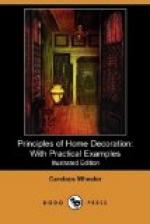An inexperienced person might think it an easy thing to make a beautiful home, because the world is full of beautiful art and manufactures, and if there is money to pay for them it would seem as easy to furnish a house with everything beautiful as to go out in the garden and gather beautiful flowers; but we must remember that the world is also full of ugly things—things false in art, in truth and in beauty—things made to sell—made with only this idea behind them, manufactured on the principle that an artificial fly is made to look something like a true one in order to catch the inexpert and the unwary. It is a curious fact that these false things—manufactures without honesty, without knowledge, without art—have a property of demoralizing the spirit of the home, and that to make it truly beautiful everything in it must be genuine as well as appropriate, and must also fit into some previously considered scheme of use and beauty.
The esthetic or beautiful aspect of the home, in short, must be created through the mind of the family or owner, and is only maintained by its or his susceptibility to true beauty and appreciation of it. It must, in fact, be a visible mould of invisible matter, like the leaf-mould one finds in mineral springs, which show the wonderful veining, branching, construction and delicacy of outline in a way which one could hardly be conscious of in the actual leaf.
If the grade or dignity of the home requires professional and scholarly art direction, the problem is how to use this professional or artistic advice without delivering over the entire creation into stranger or alien hands; without abdicating the right and privilege of personal expression. If the decorator appreciates this right, his function will be somewhat akin to that of the portrait painter; both are bound to represent the individual or family in their performances, each artist using the truest and best methods of art with the added gift of grace or charm of colour which he possesses, the one giving the physical aspect of his client and the other the mental characteristics, circumstances, position and life of the house-owner and his family. This is the true mission of the decorator, although it is not always so understood. What is called business talent may lead him to invent schemes of costliness which relate far more to his own profit than to the wishes or character of the house-owner.
But it is not always that the assistance of the specialist in decoration and furnishing is necessary. There are many homes where both are quite within the scope of the ordinary man or woman of taste. In fact, the great majority of homes come within these lines, and it is to such home-builders that rules, not involving styles, are especially of use.
The principles of truth and harmony, which underlie all beauty, may be secured in the most inexpensive cottage as well as in the broadest and most imposing residence. Indeed, the cottage has the advantage of that most potent ally of beauty—simplicity—a quality which is apt to be conspicuously absent from the schemes of decoration for the palace.




